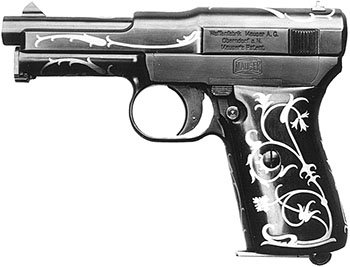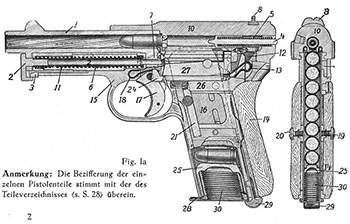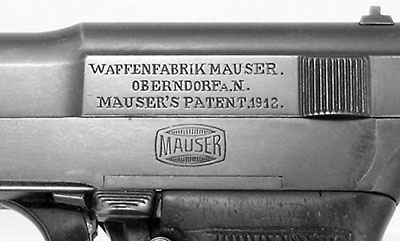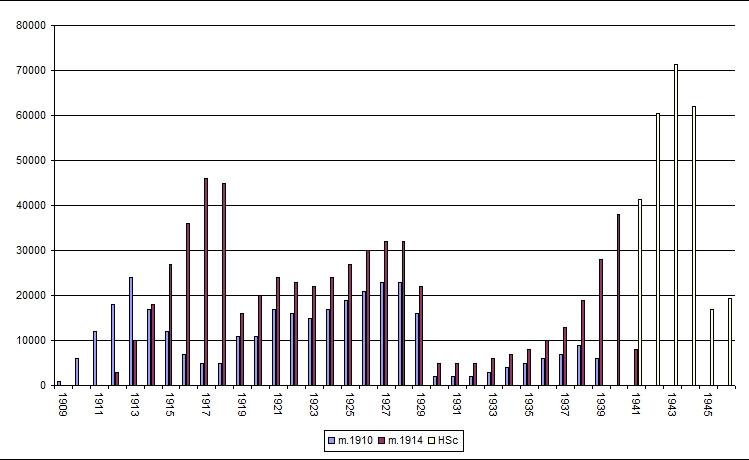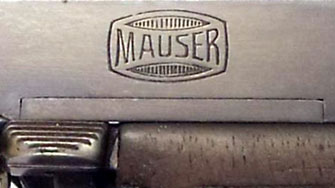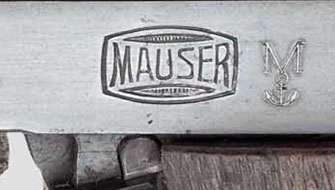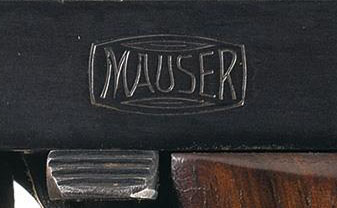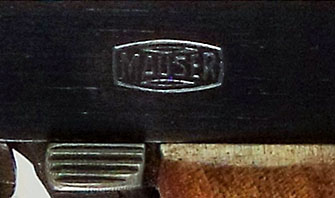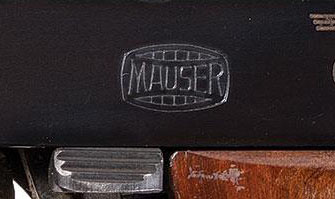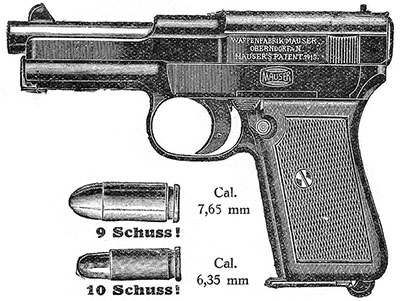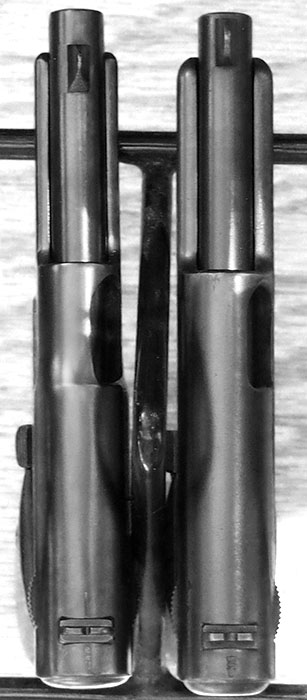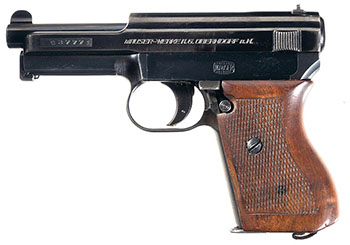 |
|||||||||||||||||||||||||||||||||||||||||||||||||||||||||||||||||||||||||||||||||||||||||||||||||||||||||||||||||||||||||||||||||||||||||||||||||||||||||||||||||||||||||||||||||||||||||||||||||||||||||||||||||||||||||||||||||||||||||||||||||||||||||||||||||||||||||||||||||||||||||||||||||||||||||||||||||||||||||||||||||||||||||||||||||||||||||||||||||||||||||||||||||||||||||||||||||||||||||
 |
|||||||||||||||||||||||||||||||||||||||||||||||||||||||||||||||||||||||||||||||||||||||||||||||||||||||||||||||||||||||||||||||||||||||||||||||||||||||||||||||||||||||||||||||||||||||||||||||||||||||||||||||||||||||||||||||||||||||||||||||||||||||||||||||||||||||||||||||||||||||||||||||||||||||||||||||||||||||||||||||||||||||||||||||||||||||||||||||||||||||||||||||||||||||||||||||||||||||||
|
Mauser Pistols: by Ed Buffaloe and Burgess Mason III
In fact, the company seems to have concentrated at this time on developing a design for the larger caliber of 9 mm. For instance, Paul Mauser had high hopes for a design known as the C06/08, a locked-breech pistol with the magazine in front of the trigger guard, but it did not fare well against Luger’s Parabellum in government evaluations. Then the Model 1909 was designed, first in 9 mm Parabellum, with an unlocked breech and a recoil buffer spring, but it proved unsatisfactory for the powerful cartridge, and so the design was scaled down to create the Model 1910 in 6.35 mm Browning cartridge, minus the recoil buffer spring. Apparently, only after the Model 1910 was developed and in production did attention turn in earnest to building a gun for the 7.65 mm Browning cartridge.
The distinctive nickname for the pistol comes from the contour of its slide, which is milled down and reduced in width and thickness over the ejection port and all the way down the front arms of the slide. The Humpback might have been called the Model 1912, except that the Model 1912 designation had already been taken by one of Mauser’s experimental pistols. The earliest known surviving example of a 7.65 mm Mauser Humpback pistol, serial number 22, has the following slide inscription on the left side of the slide in all capital serif characters: WAFFENFABRIK MAUSER.
Dating the Humpback 1914 and the New Model 1910
Above is a chart of production figures made from information published in 1999 by John LaCroix, which purportedly came from August Weiss, though no firm proof of its origin is available. Weiss did not work for Mauser until 1930, but he was placed in charge of pistol production at that time and certainly would have had access to past production data in the period when all of Mauser’s records were still intact. The chart shows 1000 Model 1910 Side Latch pistols made in 1909, 6000 in 1910, 12,000 in 1911, 18,000 in 1912, and 24,000 in 1913. Thus it neatly accounts for the approximately 61,000 Side Latch pistols that are known to have been made. The chart also shows that 3000 Model 1914 pistols were made in 1912. This happens to be the approximate number of Humpback pistols that are known to exist (the highest Humpback serial number we have recorded is 2825 and the lowest non-Humpback serial number we have recorded is 2993). The chart also shows that 10,000 Model 1914 pistols were made in 1913. Verifiable Information About Mauser Pocket Pistol Production The Mauser archive more often provides sales figures than production figures, and the figures are sometimes for a fiscal year rather than a calendar year. On page 512 of Baudino and van Vlimmeren’s book Paul Mauser we find a translation of a report to the board of directors for the fiscal year 1911, which says: “A healthy development is shown in the sales of our Mauser pocket pistol which was introduced to the market in April 1911, of which we have sold within 8 months more than 11,000 pistols....” Despite the fact that marketing began in April, sales actually began taking place in February, the first recorded sale being three pistols to the Rottweil powder factory on 15 February 1911, followed by 100 pistols to Gustav Genschow & Co. (Geco) on 22 February (see pages 512-513).
On page 430 of The Mauser Archive by Jon Speed we find the Mauser annual report for 1913. The first thing that leaps out at us is that the original document has a typographical error which is not noted in Jon Speed’s text. The German text says (our translation): “We were thus fully occupied until 1 July 1914.” However, the caption for the document says it is dated 1 January 1914, so it could not be referring forward to July 1914 but must be referring back to July 1913. The translation should read: “We were thus fully occupied until 1 July 1913. The fall in demand for our 6.35 mm pistols is due to the fact that since July the manufacture of this model has been completely halted (or interrupted) for a model change. Since then no specimen of the New Model could be brought to the market because the changes had not been completed until recently. In December the deliveries are to be resumed, while the new pocket gun of 7.65 mm is not expected to be manufactured until spring 1914.” On page 429 of The Mauser Archive by Jon Speed, right column, we find a reproduced document entitled “Orders from 1 January through 31 October 1913.” In the “ordered” column are listed 1550 Selfloading Pistols caliber 7.65 mm. In the column “produced, delivered, and paid for” is a dash, and in the third column entitled “order backlog as of 1 November” is the number 1550. So Mauser had received orders for 1550 pistols in 7.65 mm which they were unable to fill as of 31 October 1913. The earliest advertisement we have located for a Model 1914 Mauser is in a book published in 1913 entitled Moderne Gewehrfabrikation, by Otto Maretsch. It features a photograph of a 1910 Sidelatch in 6.35mm, and announces the “newest Mauser small pocket model with fixed barrel, caliber 6.35 mm and 7.65 mm, the latter being available from January 1914.” A similar notice also appeared in a book entitled Das Flintenschießen – Lehrbuch des Flintenschießens, Nebst einer Anleitung zur Herstellung von Flintenschießständen, by Albert Preuß, also published in 1913 and giving the same date of availability for the 7.65 mm pistol. (We are indebted to Martin Krause for this information.) On page 98 of Weaver, Speed, and Schmid’s Mauser Pistolen is an English language “Introductory” for the Model 1912 Armeepistole wherein it is stated: “...the well-known inventor, our Managing Director Paul von Mauser, has also designed an automatic pocket pistol for the 7.65 mm auto-cartridge. ...we have introduced in the 6.35 mm and in the 7.65 mm automatics various important improvements which were realized while carrying out practical experiments on a large scale with our 9 mm military pattern automatic pistol, model 1912/14. The 7.65 mm and the new model 6.35 mm pistols are entirely alike in their construction except for their sizes....” A footnote states: “...the Cal. 7.65 mm automatic will be available in July 1914...” In the 15 May 1914 issue of the magazine Schuss und Waffe there is an advertisement for the Mauser pocket pistol which notes that the “Caliber 7.65 mm (8 shot) [will be] available from late Autumn of 1914 onwards.” The earliest recorded sales of 7.65 mm pistols are listed on page 572 of Baudino and van Vlimmeren’s book Paul Mauser: in February of 1914 two units went “...to the DWM ammunition plant in Karlsruhe...,” one unit went to A. Stahle, a dealer in Stuttgart, and in July 1914 the Landjager Korps of Stuttgart purchased 110 units. So we see that the earliest recorded sales actually took place before the patent was officially approved.
In Mauser Pocket Pistols 1910-1946 by Roy G. Pender III (on page 99) we see a presentation Mauser Humpback pistol given to Adolph Drossel by Paul Mauser. It is inscribed with the date of March 1914 and has the serial number 130. One can certainly find reasons to doubt LaCroix’s figures, even though the figures add up to the correct number actually manufactured. There is no evidence in the sales figures or annual reports from 1909 and 1910 that any 6.35 mm pistols were manufactured. Of course, the figures cited are for commercial manufacture and would not include prototypes made by the Versuchsabteilung or experimental department. Nonetheless, the experimental department would only have made a few prototypes. If thousands of pistols were manufactured, they would have been made in the main factory, not in the experimental department, and would have been accounted for in the annual report. The critical German patents for the 6.35 mm Model 1910 Side Latch appear to have been granted by September of 1910, and this dovetails nicely with the fact that the earliest sale reported is in February of 1911. The critical patent for the New Model 1910 (6.35 mm) and the Model 1914 (7.65 mm) was filed in September of 1912, but the annual report for 1913 cited above indicates that deliveries of the New Model 1910 did not begin until December 1913 and that manufacture of the Model 1914 was not projected to begin until sometime in 1914. This is almost certainly because the patent had not yet been granted.
Humpback Design The fundamental design and the internal lockwork of the Mauser Model 1914 is identical to that of the 1910 New Model described in Part I of this article, although there are minor differences in details of the Humpback variant that need to be described. The mechanism described in patent 279890 locks the slide open when the magazine is removed, locks the sear so the gun cannot be fired without the magazine, and closes the slide when a magazine is inserted. The 1912 Humpback prototypes are likely the first guns ever made with this patented mechanism. Like the 1910 New Model in 6.35 mm, these pistols have the disconnector separate from the sear lever. Instead of having serrations cut into the flat side of the slide, the Model 1914 pistol has a semi-circular raised area at the rear of the slide on both sides. This raised area has vertical triangular-cut serrations, and requires a slightly larger steel bar stock which must be milled down to create it. This is a more expensive way to make a slide, but the raised area provides a very positive gripping surface for slide retraction, and this feature is found on the Model 1914 throughout its production life. First Variant Humpback The earliest Humpback pistols have the serial number on the top of the slide, just in front of the rear sight (up to about serial number 300). The serial number is also stamped on the rear of the frame above the grip, and either a partial or full serial number may be stamped on the bottom of the sideplate next to the trigger. Unlike sideplates on the 1910 pistols, the Humpback sideplate has a rectangular cutout on its bottom edge extending backward from just above the safety lever. The Mauser powder barrel logo on the sideplate is centered above this cutout. There is a milled rectangular depression on the right side of the frame above the right grip.
The grip is a single piece of walnut carved to closely fit the grip frame, held in place by a screw on either side. The wood grip is scored on either side in a criss-cross diamond pattern. The finish of the gun is rust blue, with the trigger, safety lever, safety release, barrel pin front plate, and grip screws in nitrate or fire blue. The magazine is nickel plated and has three slots on the left side for viewing cartridges, and a rectangular floor plate. With the exception of a few early prototype pistols with a patent date in the inscription (see above) , the left side slide inscription is on three lines in upper and lower case sans-serif characters as follows: Waffenfabrik Mauser A.G. The extractor is of a bottle-neck shape (similar to that on the 1910 Side Latch pistol). The striker has an integral guide rod that protrudes through the hole in the rear of the frame when it is cocked (like that of the 1910 New Model pistol).
There are a couple of sub-variants. The first sub-variant has a 3.4 inch (86 mm) barrel with the front sight set back less than a tenth of an inch (about 2 mm) from the muzzle. These fall in the serial number range below 200. The second sub-variant has a 4.25 inch barrel (108 mm) with the front sight set back about 5/16 inch (8 mm) from the muzzle. These fall in the serial number range between 200 and 300. Second Variant Humpback The second variant has the serial number on the left arm of the slide, near the front. Transition pistols may have the serial number both on the top and side of the slide.
Third Variant Humpback The third variant Humpback has a long, straight extractor, starting at about serial number 2000. Fourth Variant Humpback Starting at about serial number 2590 the cutout at the bottom of the sideplate is eliminated and the slide address is changed to two lines in upper and lower case sans-serif characters as follows: Waffenfabrik Mauser A.G. The following use markings are found on Humpback Mauser pistols:
These early Model 1914 pistols are identical to the late Humpback pistols with the two-line slide inscription, except that the slide is not milled down over and in front of the ejection port. The new slide is 25 grams heavier than the early slide. The Humpback slide weighs 198 grams (6.95 ounces) whereas the new unmilled slide weighs 223 grams (7.85 ounces). With just over 10,000 made, this is a relatively scarce variant.
This variant is defined by its one-line slide inscription in all capital sans-serif characters: WAFFENFABRIK MAUSER A.G. OBERNDORFA.N. MAUSER’S PATENT
With the advent of World War I, production was quickly ramped up to fill military orders. With over 276,000 made, this is the most common variant of the Model 1914. Pender refers to it as the Wartime Commercial 1914. A few of the guns (between serial number 68000 and 70500) may be found with a 4.25 inch barrel with the sight set back about 5/16 inch from the muzzle. Around serial number 162500 a right side slide legend appears in upper and lower case sans-serif characters as follows: Mauser-7,65 Later it appears as follows: Mauser-7,65
The caliber marking, in one form or another, continues in use for all subsequent guns. Starting around serial number 172000 we begin to see intermittent guns with no Mauser logo on the sideplate. This may have been due to the exigencies of wartime production. Beginning at about serial number 277000 the milled depression above the right grip is eliminated. This simplified production. The gun is finished in the traditional rust blue, with small parts such as the trigger, extractor, safety release, grip screws, barrel pin front plate, and sometimes the magazine base plate in nitrate blue. The grips continue to be largely in walnut, as described above, though checkered rubber grips for the 7.65 mm pistol were introduced, with the Mauser-Werke MW monogram near the top on either side. Magazine bodies are unblued “in the white” and have three slots in the left side for viewing cartridges. The magazine base has a split or “T” tail on lower serial numbers and a half-moon indentation on higher serial numbers. Some examples in this serial number range will be found with the following use markings:
Because the Model 1914 was introduced just before the beginning of World War I, it did not become available for commercial sales outside of Germany until after the war. Even though the German military had purchased very large quantities of the gun during the war, it was not the standard issue military pistol and so did not fall under the post-war restrictions imposed by the allies. This variant was manufactured from approximately 1923 to 1929, with approximately 178,000 made . The fourth variant Model 1914 is defined by its two-line slide address in all capital sans-serif characters as follows: WAFFENFABRIK MAUSER A.G. OBERNDORFA.N.
A few early examples will be found without the Mauser banner on the sideplate. The right side inscription is in all capital sans-serif characters: MAUSER - 7,65
After about serial number 461000 the right side slide inscription was changed to read: Cal. 7,65 The front sight has a round half-moon shape, though early examples may have the ramp front sight. The finish is identical to that of the earlier variant, as is the grip, which continues to be available in either wood or plastic. At about serial number 460000 the finish is changed to a salt blue. The magazine continues to be unblued “in the white,” with a blued base plate that has a slot on one side into which the end of the magazine spring is inserted in order to retain the plate. Some of these guns are found with an extra barrel for the 4 mm M20 rimfire practice/training ammunition. The 4 mm barrels were available separately, but if the gun was sold with the practice barrel it will be numbered to the gun. Some examples in this serial number range have the following use markings:
In 1922 Waffenfabrik Mauser AG changed its name to Mauser-Werke AG to reflect its diversification into other manufacturing sectors after World War I. This change was realized in the slide inscription of the 7.65 mm pistol in 1929. The new slide inscription, which defines this variant, was in all capital sans-serif italic characters as follows. MAUSER-WERKE A.G. OBERNDORF A.N.
The fifth variant was made from 1929 until 1933, with approximately 58,000 made. Initially, the new left side slide inscription was the only change made to this variant, but at about serial number 488000 the right side slide inscription was changed to read, in sans-serif characters, as follows: Cal. 7,65 D.R.P.u.A.P. The abbreviation stands for Deutsches Reich Patent und Ausländische Patente (German and foreign patents).
At about serial number 475000 we begin to see intermittent barrel pin release catches that are stamped instead of milled--the stamped catch is simply a piece of spring steel that has been bent to a curved shape at the end and then tempered. At about serial number 476000 we begin to see intermittent stamped magazine release catches, made in the same way as the barrel pin release catches, but with triangular grooves cut in the bottom to make them easier to operate. At about serial number 496000 the serial number on the left side of the slide begins to appear in a milled depression. Most magazines in this variant will have the Mauser powder barrel logo on the bottom, and the baseplate will be blued. Beginning around serial number 475000 and through serial number 526000 we find intermittent guns, all with black grips, with lanyard rings on a screw that runs through the heel of the grip. Pender refers to these as Scandanavian police pistols. Some examples in this serial number range have the following use markings:
The grips are either walnut or Trolit plastic (made by Rheinisch-Westfälischen Sprengstoff-Fabriken, abbreviated as RWS). By this time the stamped barrel pin catch and magazine release have become standard. Black grip guns are found intermittently with lanyard rings between serial numbers 529000 and 539000. Around serial number 532000 the size of the D.R.P.u.A.P. patent notice on the right side was reduced to about half the size of the caliber marking. Later, some examples appear with a slightly larger patent notice, though still smaller than the caliber marking. Through approximately serial number 577000 the guns are proofed with the crown over U proof. Above 577000 the guns are proofed with the Nazi eagle over N proof. Some examples in this serial number range have the following use markings:
Part I: The Mauser Model 1910 |
|||||||||||||||||||||||||||||||||||||||||||||||||||||||||||||||||||||||||||||||||||||||||||||||||||||||||||||||||||||||||||||||||||||||||||||||||||||||||||||||||||||||||||||||||||||||||||||||||||||||||||||||||||||||||||||||||||||||||||||||||||||||||||||||||||||||||||||||||||||||||||||||||||||||||||||||||||||||||||||||||||||||||||||||||||||||||||||||||||||||||||||||||||||||||||||||||||||||||
|
* Please email Burgess Mason with photographs, information, or inquiries about Mauser pistols. |
|||||||||||||||||||||||||||||||||||||||||||||||||||||||||||||||||||||||||||||||||||||||||||||||||||||||||||||||||||||||||||||||||||||||||||||||||||||||||||||||||||||||||||||||||||||||||||||||||||||||||||||||||||||||||||||||||||||||||||||||||||||||||||||||||||||||||||||||||||||||||||||||||||||||||||||||||||||||||||||||||||||||||||||||||||||||||||||||||||||||||||||||||||||||||||||||||||||||||
|
|||||||||||||||||||||||||||||||||||||||||||||||||||||||||||||||||||||||||||||||||||||||||||||||||||||||||||||||||||||||||||||||||||||||||||||||||||||||||||||||||||||||||||||||||||||||||||||||||||||||||||||||||||||||||||||||||||||||||||||||||||||||||||||||||||||||||||||||||||||||||||||||||||||||||||||||||||||||||||||||||||||||||||||||||||||||||||||||||||||||||||||||||||||||||||||||||||||||||
|
Copyright 2017 by Ed Buffaloe and Burgess Mason. All rights reserved. |
|||||||||||||||||||||||||||||||||||||||||||||||||||||||||||||||||||||||||||||||||||||||||||||||||||||||||||||||||||||||||||||||||||||||||||||||||||||||||||||||||||||||||||||||||||||||||||||||||||||||||||||||||||||||||||||||||||||||||||||||||||||||||||||||||||||||||||||||||||||||||||||||||||||||||||||||||||||||||||||||||||||||||||||||||||||||||||||||||||||||||||||||||||||||||||||||||||||||||
|
|
|||||||||||||||||||||||||||||||||||||||||||||||||||||||||||||||||||||||||||||||||||||||||||||||||||||||||||||||||||||||||||||||||||||||||||||||||||||||||||||||||||||||||||||||||||||||||||||||||||||||||||||||||||||||||||||||||||||||||||||||||||||||||||||||||||||||||||||||||||||||||||||||||||||||||||||||||||||||||||||||||||||||||||||||||||||||||||||||||||||||||||||||||||||||||||||||||||||||||
